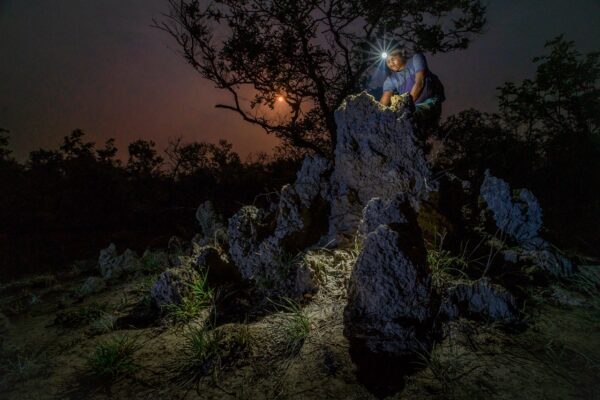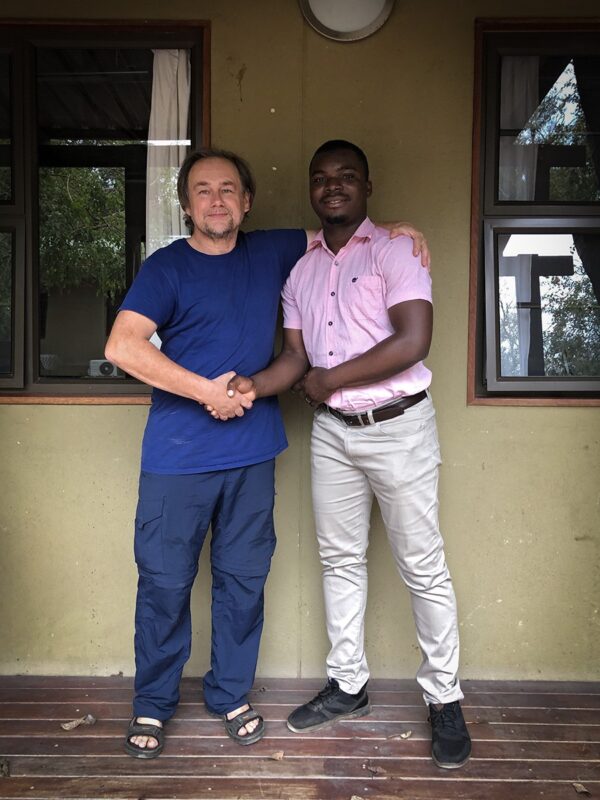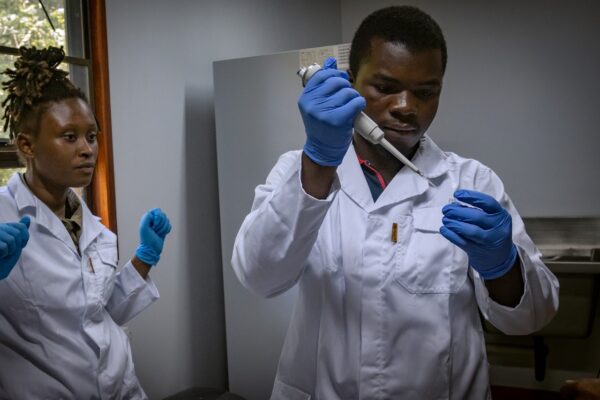

The E.O. Wilson Biodiversity Foundation mourns the loss of Ricardo Guta (1991 – 2022) who passed away in December. Ricardo, a native Mozambican, was named the inaugural “Half-Earth Scholar” in 2020 by the E.O. Wilson Biodiversity Foundation, and was a recent M.Sc. graduate in Conservation Biology at the University of Cape Town studying the phylogeography of flightless spring katydids in the Greater Cape Floristic Region. Half-Earth Scholars are selected for their potential to become the next generation of biodiversity research leaders and to serve as exemplars for careers in conservation research and action. Ricardo was conducting field research on the Cederberg plateau north of Cape Town, South Africa when the accident occurred.
“Ricardo was a bright star with a passion for exploration and discovery. In both practice and spirit, he shared E.O. Wilson’s quest to understand everything he could about “the little things that run the world,” and was a beacon of hope for future stewardship of the planet,” shared Paula Ehrlich, President and CEO of the E.O. Wilson Biodiversity Foundation.
Ricardo was born in 1991 and raised in the city of Beira, Sofala Province, Mozambique. He achieved a degree in agro-livestock from the Agricultural Institute of Chimoio.


Ricardo Guta, Gorongosa National Park, photo by Piotr Naskrecki.
In 2012, Ricardo founded the PROTESCA project (Animal Protection and Health Project), providing technical assistance to animals through health, food and reproduction management, including research on phytotherapeutic plants for the treatment and nutrition of animals.
Ricardo joined the Gorongosa National Park research team as an intern on a biodiversity survey project and later worked for seven years at the E.O. Wilson Biodiversity Laboratory in Gorongosa National Park as a research technician focusing on insect biodiversity. He completed his undergraduate Biological Sciences degree at the Universidade Lúrio in Mozambique. More recently, he worked with the African Honeyguides Project to better understand the effect of human-honeyguide mutualism on honeybee behavior and ecology, and pollination in Niassa Special Reserve.
Dennis Liu, VP of Education said, “I was fortunate to have been able to have several great discussions with Ricardo. He was so proud of his work in Gorongosa and excited to share insights into the natural beauty of Mozambique. Like a true budding scientist, he was eager to share the deep insights he was acquiring into Katydids in the park. He had a sense of humor that made even his most technical explanations seem light. Mozambique has lost a really good one, and I will miss him while hoping his example inspires other biodiversity enthusiasts.”
In 2019 Ricardo co-authored, Katydids (Orthoptera: Tettigoniidae) of Gorongosa National Park and Central Mozambique, the result of 6 years of fieldwork with Dr. Piotr Naskrecki, Associate Director of the E.O. Wilson Lab in Gorongosa National Park. The paper describes the biology, distribution, and acoustic behavior (songs produced by these insects) of all 60 species living in the region. It also describes 9 new to science species discovered in Gorongosa; two of these species belong to entirely new genera. Twenty-four species are also recorded for the first time in Mozambique. At least two of the newly discovered species are endemic to Gorongosa (they can be found nowhere else in the world) and they occur in the unique rainforest of Mt. Gorongosa. One new species, Enyaliopsis iaculator, has an unusual defensive behavior of shooting its own blood at the attackers.
Ricardo’s 2021 paper, A new Gonamytta katydid from central Mozambique (Orthoptera: Tettigoniidae: Meconematinae, identified and described a new katydid species with an ultrasonic call.
Before Ricardo passed, he successfully defended his M.Sc. and was enrolled in a PhD program in entomology at University of Cape Town, exploring the influence of honeyguide-human mutualism on honeybee ecology.


Ricardo Guta, Piotr Naskreki, Gorongosa National Park.
Half-Earth Project inaugural Chair, long-time mentor, and colleague, Dr. Naskrecki wrote, “he (Ricardo) was a brilliant, inquisitive, kind person. His thesis advisor called him “one in a billion” and I couldn’t agree more. What is even more tragic is that he had just celebrated the birth of his son (whom he decided to name Piotr and, by a remarkable coincidence, his son was born on the exact same date as me – we were already planning to have a joint birthday celebration next year in Costa Rica.) I am simply devastated by the news.”


Noriña Vicente, Ricardo Guta, photo by Piotr Naskrecki.
His colleague and fellow Half-Earth Scholar, Noriña Vicente, shared this tribute, “I am so glad that I had the opportunity to have you as an advisor, mentor, and inspiration for the future that I wanted to be. Ricardo was the mirror I always admired, and I used his pathways to conquer mines. He was very passionate about everything regarding wildlife, even everyday things; he would always explain and make anyone fall in love with nature. He was a true conservationist and entomologist with immeasurable curiosity, and as a good scientist, he would find scientific reasons for everything he saw.
Besides being a tremendous scientist, Ricardo was a friend; without him, the field expeditions will never be the same. Backlighting without him will be strange; I will find myself looking at every orthoptera and not being able to ask about the species and its behavior, looking for insects far from the light, and laughing for no reason sometimes. Ricardo was always respectful, very humble, and very honest. He had the instinct to bring out the best in everyone who met him, and so did I. As field trip patterner, we were always singing while traveling to the field, inventing things to eat and photographing our beloved ones.
Ricardo Guta, I will miss you, my friend, dearly. You have gone too young, but you have contributed much to our country. Your legacy shall continue, and future generations will know the greats you have done while here. Rest in Peace, my dear friend.”
Ricardo advocated for the goal to protect global biodiversity by conserving a sufficient amount of Earth’s land and seas for Nature (Half-Earth) through his research and participation in two events with the E.O. Wilson Biodiversity Foundation, remote panels from Gorongosa in 2020 and Half-Earth Day 2021.
Upon the passing of E.O. Wilson in December 2021, Ricardo shared, “Inspired by his work, I now feel it is my mission as a young scientist, taxonomist, and conservationist to document biodiversity to make the world a better place. For this reason, I have currently been carrying out several independent works aimed at identifying species in conservation areas and recently in urban areas, mainly expansion areas as these still contain semi-native vegetation that holds a great diversity that overtime is lost with urbanization. The knowledge of biodiversity can change the way societies build their homes, maintaining green spaces to ensure species protection.”
Ricardo is survived by his wife Lailat and children Adrielle and Piotr.
Peer-Reviewed Papers
- Guta, R., Macamo, L. and Naskrecki, P. (2021) A new Gonamytta katydid from central Mozambique (Orthoptera: Tettigoniidae: Meconematinae). Zootaxa 5027(1), 120–126. DOI: 10.11646/zootaxa.5027.1.6.
- A new small predatory katydid Gonamytta deboisselae sp. n. is described from mid-elevation montane forest habitat in central Mozambique; this species is a putative endemic of Mt. Gorongosa. The call of the new species is ultrasonic, with the peak frequency at 38.2 kHz. Anepitacta (A.) scrofina Beier, 1965 is transferred to Gonamytta based on the morphology of the male terminalia.
- Naskrecki, P. and Guta, R. (2019) Katydids (Orthoptera: Tettigoniidae) of Gorongosa National Park and Central Mozambique. Zootaxa 4682(1), 1–119. DOI: 10.11646/zootaxa.4682.1.1.
Videos featuring Ricardo Guta
Young Scientists of Gorongosa, Ricardo Guta (2020)
Half-Earth Educator Ambassador Discussion: Ricardo Guta and Noriña Vicente (2020)
Ricardo Guta, Inaugural Half-Earth Scholar (2020)
Half-Earth Day 2021 – Voices: Half-Earth Day 2021 (featuring Ricardo Guta)
Half-Earth Day 2021: Dream to Reality (Ricardo Guta at 29 min. 54 sec.)

